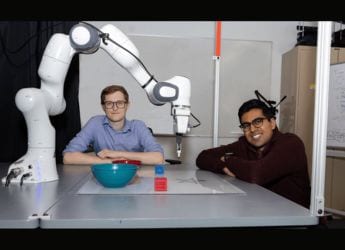- Home
- Science
- Science News
- Scientists Develop Heart Helical Structure Model That Could Help Create Artificial Heart
Scientists Develop Heart Helical Structure Model That Could Help Create Artificial Heart
The fabrication of a human heart is crucial as a heart cannot repair itself after injuries like other organs.

Photo Credit: Michael Rosnach/Harvard SEAS
The fabrication of human heart is crucial as heart cannot repair itself after injuries
Paving the way for the fabrication of artificial hearts, bioengineers at the Harvard John A. Paulson School of Engineering and Applied Sciences (SEAS) have successfully created a biohybrid model of human ventricles. The fabrication of a human heart is crucial as a heart cannot repair itself after injuries like other organs. But, to do so, researchers need to replicate the complex structure of the heart which includes helical geometrics that is responsible for twisting motions as the heart beats.
While it has been believed that the twisting motion is important for pumping blood in high volumes, scientists could not prove that. This was partly because creating hearts with different geometrics has been tricky. In the new study published in Science, scientists have been able to demonstrate that muscle alignment increases the amount of blood that the ventricles can pump while contracting.
“This work is a major step forward for organ biofabrication and brings us closer to our ultimate goal of building a human heart for transplant,” said Kit Parker, the Tarr Family Professor of Bioengineering and Applied Physics at SEAS and senior author of the paper.
To reach the conclusion, scientists drummed up a new method of additive textile manufacturing, Focused Rotary Jet Spinning (FRJS). This allowed them to fabricate the helically aligned fibres with diameters ranging from several micrometers to hundreds of nanometers.
With the model, scientists tried to test the hypothesis of Edward Sallin, former chair of the Department of Biomathematics at the University of Alabama Birmingham Medical School, who claimed that helical alignment was critical for large ejection fractions.
“The human heart actually has multiple layers of helically aligned muscles with different angles of alignment. With FRJS, we can recreate those complex structures in a really precise way, forming single and even four-chambered ventricle structures,” explained Huibin Chang, a postdoctoral fellow at SEAS and co-author of the study.
Get your daily dose of tech news, reviews, and insights, in under 80 characters on Gadgets 360 Turbo. Connect with fellow tech lovers on our Forum. Follow us on X, Facebook, WhatsApp, Threads and Google News for instant updates. Catch all the action on our YouTube channel.
- Samsung Galaxy Unpacked 2025
- ChatGPT
- Redmi Note 14 Pro+
- iPhone 16
- Apple Vision Pro
- Oneplus 12
- OnePlus Nord CE 3 Lite 5G
- iPhone 13
- Xiaomi 14 Pro
- Oppo Find N3
- Tecno Spark Go (2023)
- Realme V30
- Best Phones Under 25000
- Samsung Galaxy S24 Series
- Cryptocurrency
- iQoo 12
- Samsung Galaxy S24 Ultra
- Giottus
- Samsung Galaxy Z Flip 5
- Apple 'Scary Fast'
- Housefull 5
- GoPro Hero 12 Black Review
- Invincible Season 2
- JioGlass
- HD Ready TV
- Laptop Under 50000
- Smartwatch Under 10000
- Latest Mobile Phones
- Compare Phones
- Huawei Nova 15
- Huawei Nova 15 Pro
- Huawei Nova 15 Ultra
- OnePlus 15R
- Realme Narzo 90x 5G
- Realme Narzo 90 5G
- Vivo S50 Pro Mini
- Vivo S50
- Asus ProArt P16
- MacBook Pro 14-inch (M5, 2025)
- Huawei MatePad 11.5 (2026)
- OnePlus Pad Go 2 (5G)
- OnePlus Watch Lite
- Just Corseca Skywatch Pro
- Acerpure Nitro Z Series 100-inch QLED TV
- Samsung 43 Inch LED Ultra HD (4K) Smart TV (UA43UE81AFULXL)
- Asus ROG Ally
- Nintendo Switch Lite
- Haier 1.6 Ton 5 Star Inverter Split AC (HSU19G-MZAID5BN-INV)
- Haier 1.6 Ton 5 Star Inverter Split AC (HSU19G-MZAIM5BN-INV)












